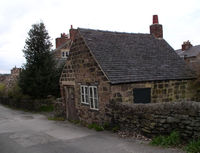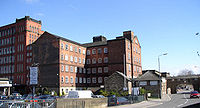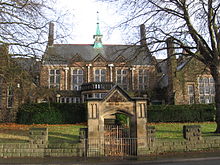Information About Belper
Updated: August 16 2018 | Belper Research Website now has a Facebook Group and Twitter Account
Belper is a small rural town in Derbyshire, England with a population of around 21,000. The nearest city is Derby, ten miles by road or rail. The local government district is Amber Valley. The river Derwent and the A6 trunk road, a former turnpike, run along the western edge of the town.Origins
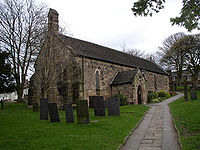 At the time of the Norman occupation, Belper was part of the land centred on Duffield held by the family of Henry de Ferrers. The Domesday Survey records a manor of "Bradley" which is thought to have been somewhere in the vicinity of the Coppice. At that time it was probably within the Forest of East Derbyshire which covered the whole of the county east of the Derwent. It was possibly appropriated by William de Ferrers, 4th Earl of Derby at some time after it was disafforested in 1225 and became part of Duffield Frith
At the time of the Norman occupation, Belper was part of the land centred on Duffield held by the family of Henry de Ferrers. The Domesday Survey records a manor of "Bradley" which is thought to have been somewhere in the vicinity of the Coppice. At that time it was probably within the Forest of East Derbyshire which covered the whole of the county east of the Derwent. It was possibly appropriated by William de Ferrers, 4th Earl of Derby at some time after it was disafforested in 1225 and became part of Duffield Frith
The town's name is often said to be a corruption of the name Beaurepaire (beautiful retreat), the name given to a hunting lodge, the first record being a charter of 1231. This would have been the property of Edmund Crouchback, 1st Earl of Lancaster who died in 1296, the record of his estate mentioning "a capital mansion".
This oft-repeated fact about the old name for Belper could be incorrect. Another explanation given in older books is that the name Belper is derived from "Bel-Pere" meaning beautiful stone because of the famous quantity and quality of the stone quarried in this location. It may be that a subsequent play on words by some wit (royal or otherwise) led to the joke of Bel Perre being such a beautiful location that it was Bel RE-Perre!! - or BEAU, to make it grammatical. However, this version of the name caught on and is found in many old documents, rendered as Beaurep'd.
The chapel built at that time still exists (see photo). Originally consecrated in 1250 as the Chapel of St. Thomas, it was rededicated to St. John during the reign of King Henry VIII.
History
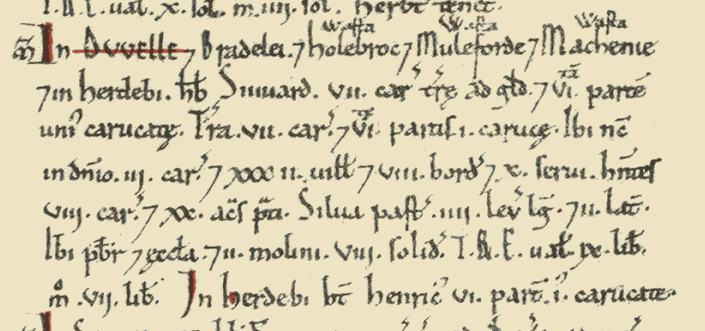 There may have been Roman settlements in and around the river. Later, the Domesday Book speaks of a hamlet known as Bradley or Bradelei having "8.5 Households, 32 villagers, 8 smallholders, 10 slaves, 1 priest." The name is now reflected in the store De Bradelei Mills in Chapel Street.
There may have been Roman settlements in and around the river. Later, the Domesday Book speaks of a hamlet known as Bradley or Bradelei having "8.5 Households, 32 villagers, 8 smallholders, 10 slaves, 1 priest." The name is now reflected in the store De Bradelei Mills in Chapel Street.
From the 11th century the Ferrers family controlled the area from a massive Norman castle at Duffield and in the 13th century a Manor House and Chapel were built. See the photo of St John's Chapel above. By the 14th century there is a deer park within Duffield Frith with a hunting lodge and chapel.
The coal deposits of Derbyshire are frequently associated with ironstone and its availability together with charcoal and coal meant that Belper became a centre for nailmaking, from as early as the twelfth century. In 1314-15 the Duchy of Lancaster recorded two forges producing iron bars for chapel windows, nails and spikes. Horseshoes and nails were supplied to huntsmen visiting theRoyal Forest. By the end of the eighteenth century there were around 500 nailer's workshops in the town. Nailmaking continued during the Industrial Revolution, but was eventually superceded by the cotton mills.
From at least the 13th century there were forges in the Belper and Duffield areas and it became a major source of income, particularly for nail making. By the end of the eighteenth century there were around 500 'naylor's' workshops in the town. It was hot exhausting work for very little remuneration and by the end of the century they had been superseded by machinery.
At the beginning of the industrial revolution Belper's population was only around 500. A hundred years later in 1830 this figure had risen to around 8,000. The reason was the availability of work in the mills and good workers' housing.
The construction of Jedediah Strutt's mills brought many workers to Belper. By 1792 Belper had five mills and new rows of cottages to house the workers. The Strutt family also provided a chapel and schooling for their employees and child workers.
Belper was one of the first 'mill towns', as a progression of events in Derby and nearby Cromford. The industrialist Jedediah Strutt was initially a partner of Richard Arkwright and built a water-powered cotton mill at Cromford, followed by his own at Belper. In 1784 he built the North Mill, and across the road joined by a gangway, the West Mill. In 1803 the North Mill was burnt down to be replaced by an innovative new structure designed to be fireproof. Other extensions followed, culminating in the East Mill in 1913, a present day Belper landmark. To this day the mill derives power from the river, using turbine-driven electrical generators.
In 1740, the population of Belper was around 500. By the 1830's it had risen to around 8000. Its rapid growth and development is due in large part to the building of the mills and mill-workers' housing. The Strutt family were great benefactors of the town for some 150 years, providing for their workers employment, housing, education and even food from its model farms.
Much of the mill site was cleared in the 1960's. All that nowadays remains of Strutt's Mills is the large East Mill and the smaller North Mill, preserved as part of the Derwent Valley Mills heritage sites.
The weir at Belper used to power four mill complexes. Even now it provides all the electricity for the North and East Mills.
Below the mill complex, the River Derwent is spanned by a fine stone bridge of 1795, replacing the old one washed away in a flood. The beautiful (and recently restored) River Gardens offered boating on the river and brass band music at the bandstand.
In 1820 Belper was the first place in the UK to get gas lighting, at a works erected by the Strutts at Milford. Demand was such that in 1850, the Belper Gas and Coke Company was formed, with a works in Goods Road. The railway was built by George Stevenson in 1838 and was thought to be a marvel of engineering.
John Ward and George Brettle established a hoisery business which once employed hundreds of people. The George Brettle Warehouse, built in classical style in 1834, still survives in Chapel Street.
Belper remained a textile and hosiery centre well into the Twentieth century. Other companies helped the town's development, including the Park Foundry, a leader in the solid fuel central heating market, and the Deb factory which produced Swarfega. Thornton's, the chocolate maker, moved into the town from Sheffield, which helped to alleviate the employment problems after the war although they have now relocated.
Please also visit Derbyshire and Peak District Photographs for larger photographs from Belper including many from Strutt's North Mill
Schools
Belper School and Sixth Form Centre (the town's secondary school) has approximately 1400 pupils aged 11–18. It was originally named "Belper High School" when it was built in 1973, and is adjacent to Belper Leisure Centre. Its most famous "old boy" is probably Ross Davenport, winner of two gold medals at the 2006 Commonwealth Games. Another former pupil of note is the late Alison Hargreaves, holder of a number of 'firsts' in the mountaineering world.
Among the Strutts' bequests to the town was the Herbert Strutt Grammar School built in 1909. This became a primary school in 1973 with the opening of Belper High School, and remained in use as such until the Easter break in 2008 when it was replaced by a new building on the edge of the town.
Notable among its students were the actors Alan Bates and Timothy Dalton, while the actress Suzy Kendall was born and grew up in the town.
Churches
The oldest place of worship is St John's Church, said to have been built by Edmund Crouchback, Earl of Lancaster, in the 13th century. It has undergone only minor restoration since. Its use as a church declined when St Peters Parish Church was erected in 1822-24, followed by Christ Church in 1849. It has been used as a school house in the past, and a meeting place for many local organizations.
The oldest of the current churches is Belper Unitarian Church built in 1788. The present Methodist Church was opened on June 28, 1807 and was originally built to hold 1400 worshippers.
A prominent landmark, St Peter's Anglican Church was built in 1824 to replace St John's Chapel. A second Anglican Church, Christ Church, was built in 1850. A local saying calls St Peter's "the low church in the high place" and Christ Church "the high church in the low place" based on their locations and different liturgical traditions.
The town is also home to a Baptist, a spiritualist, a Catholic and other Methodist Churches at Openwoodgate and Kilburn, as well as Emmanuel Community Church which is based in Duffield.
International relations
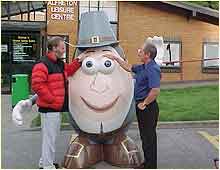 Twin towns - Sister cities
Twin towns - Sister cities
Belper is twinned with Pawtucket, Rhode Island , the connection being Samuel Slater of Milford who was an apprentice of Jedediah Strutt.
He allegedly absconded to America to found that country's cotton spinning industry.
Belper made international news in 2001 after voting to remove from sight a gift of a large fibreglass Mr. Potato Head model from Pawtucket, as residents considered the £6,000 plastic effigy "ugly".
Famous residents
- Ross Davenport Belper-born swimmer who won two gold medals and a silver at the 2006 Commonwealth Games.
- George Brown, Baron George-Brown Labour politician, Foreign Secretary 1965-7 represented Belper from 1945 until 1970.
- Timothy Dalton, actor, the 4th James Bond was raised in Belper.
- Monica Edwards, children's writer was born in Belper in 1912.
- Penelope Mortimer, novelist and wife of John Mortimer, author of The Pumpkin Eater, was the daughter of the vicar of St Peter's church.
- John Lawton, novelist, author of Black Out and Blue Rondo was born in Belper.
- Suzy Kendall, first wife of Dudley Moore, actress in British and Italian films.
- Will Hay, comedian and actor lived in Belper while performing locally in the 1920s.
- Tracy Shaw who played Maxine Peacock (1995–2003) in Coronation Street.
- Alan Bates and Graham Haberfield, actors, both attended Strutts school.
- Samuel Slater "father of the American industrial revolution" grew up on Chevin Road and was apprenticed at Milford.
- Bombardier Charles Stone who was awarded the Victoria Cross is buried in Belper.
- Frank Swettenham, colonial ruler of Malaya, author, was born in Belper in 1850.
- Audley Bowdler Williamson, inventor of Swarfega and founder of Deb Ltd., once based in Belper.
- Admiral Sir Trevor Alan Soar, the current Commander in Chief Fleet of the Royal Navy was born in Belper.
- Ron Webster professional footballer, born 1943. Webster played 455 league games for Derby County between 1960 and 1978.
Contents
Records
- Census
1851-1891 - Polls & Taxes
Early Records - Parish Records
From LDS Website - Military Records
of Derbyshire - Burials
And Memorial Records - Baptisms
From Various Sources - Marriages
Belper & Local - Documents
Matlock Record Office

